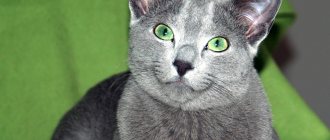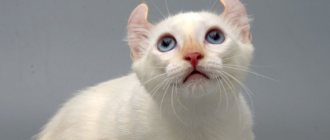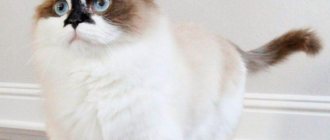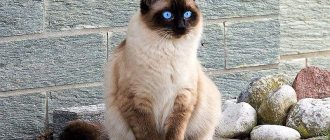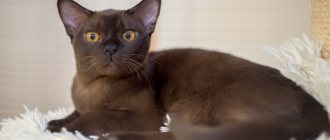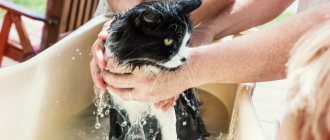Save the article:
One of the most independent cats in character, they are so imposing and beautiful that their royalty has not been disputed for a long time. There are different versions talking about the reasons for their independent character and the birth of British cats . A gray fur coat, amber eyes, thick undercoat and a stern, piercing gaze into the very soul - this is what the British cat breed is. These are one of the most beloved cats in the world, who enjoy human love quite rightly.
Key facts
The British cat is a representative of a breed that was mainly a creation of nature, and not the result of human selection. This animal combines excellent external characteristics, a calm character and excellent health. Living in the same house with a British person will bring the owners pleasure from communicating with him.
Individuals of this breed have lived in the UK for a long time, so in their country of origin they are called “shorthair” for short, which means “short-haired”. Indeed, the British cat's coat has a plush feel to the touch; this is a key characteristic of the British cat. In general, they are valued not only for their round, charming muzzle or proportional body. These cats have always been considered excellent mousecatchers.
The description of the British cat breed says that these animals love company, but they are unlikely to ask to be held or lie on your lap. They prefer to have their own space and do not want it to be invaded.
Thanks to good health, the average life expectancy of a British cat is 12-17 years, but there are long-livers who live up to 20 years. Males are slightly larger than females. Thus, the weight of males can reach 5-8 kg, and that of cats up to 4.5-6 kg. The height of the animals at the withers is about 28-32 cm.
Colors with white
A cat can have any of the following colors: black, blue, lilac, chocolate, red, cream, cinnamon and fawn, as well as a combination of these plus white spots. One fourth (no less!) part of the body should be white - this is the chest, front legs, cheeks, and belly. The nose and paw pads should match the base color.
Classic color with white
Strictly speaking, this is a two-colored cat. Elegant white spots (yellowishness is not allowed) and a fur coat of any of the classic colors. The nose and paw pads match the base color.
Smoky color with white
The cat has a symmetrically and harmoniously distributed white color (chest, paws, cheeks) and “smoky” spots of any color.
Color point with white
The elegant coat of such a cat is painted in two colors: white and any of the palettes with point marks. The chest and front legs are white, and there are also white spots on the cheeks. The symmetry of white spots and their harmonious arrangement are appreciated. Markings of black, blue, lilac, chocolate, red, cream, cinnamon and fawn. The nose and paw pads match the base color.
Colors with white tabby
The same patchwork turtles, only some spots may have a tabby pattern. Rarely seen, it is considered a combination of three colors. There may also be spots of the same (any) color, on which a tabby pattern appears (stripes, spots, marble).
History of the origin of the British cat
The history of the appearance of cats in Great Britain is covered with the dust of time. Some researchers believe that they sailed on the ships of Roman legionnaires. Cats served as rat catchers there, protecting food in the holds from rodents. However, those animals were graceful in build with long legs and bore little resemblance to modern Britons.
Over time, the imported cats went wild, mixing with local relatives. They helped peasants fight harmful rodents, receiving shelter and food for this. Pet owners did not think about the appearance of the cats, their color, the shape of the tail and ears, so the exterior of the breed was shaped by nature itself.
Only in the second half of the 19th century did people become interested in breeding these beautiful animals. This was due to their increased popularity among representatives of the upper class. This is confirmed by graphic sketches by the Englishman Louis Wayne, in which cats in the role of people play bridge or golf, have a picnic, play music, ride in a sleigh, and read newspapers. Such cheerful drawings captivated the prim Englishmen, and since then the popularity of the breed has only grown.
The first international cat show took place in London on July 13, 1871. It was attended by 170 furry participants with their owners. The procedure for conducting shows and the evaluation system was developed by a passionate lover of mustachioed pets, Harrison Weier. Invited aristocrats and ordinary people were amazed by the elegance of British cats, their beauty and intelligence. The day after the exhibition, a blue tabby named Old Lady became the adornment of newspaper pages. Since then, clubs for cat lovers and the first nurseries for breeding the British breed began to appear everywhere in Foggy Albion.
A terrible situation arose during the Second World War. Then not only people, but also domestic animals died under bombing, from hunger, and infectious diseases. The number of representatives of the breed has decreased significantly. After the war, in order to preserve the breed, they began crossing with Russian Blue and Persian cats. Because of this, the purity of the breed was not officially recognized for a long time. As a result, only in 1970 the British cat was allowed to participate in international exhibitions.
Tabby colors
The main signs of a tabby (or wild color) are the letter M located on the animal’s forehead (according to legend, this is the sign of a scarab), dark stripes near the eyes and on the cheeks, as well as rings (necklace) on the neck and chest.
Marbled Tabby
Dark circles, swirls and patterns on a light background. The pattern should be clear, not tangled or intersecting.
Spotted Tabby
Stripes on the cheeks, a dotted stripe along the ridge, and spots on the sides, preferably clearly defined and bright, are required. The cat is a micro-leopard.
Striped tabby
Brindle (sprat, mackerel, striped) is the most common tabby color. Mackerel (mackerel) fish, as well as sprat fish, have tiger stripes on their scales, just like cats have on their fur, hence the name.
Distinctive features are a dark stripe along the ridge, extending onto the tail, and striped sides. It is important that the stripes are not interrupted and do not turn into spots. The cat is a micro-tiger.
Patterned with white (torbico)
Quite a rare color, consists of three: tabby, tortoiseshell, white. On a white background there are colored spots with one of the tabby patterns.
Pictured tortoiseshell (torby)
The animal has a tabby pattern under any of the coat colors (black-red, chocolate-red, blue-cream, lilac-cream, as well as cinnamon-red and fawn-cream).
Silver tabbies
The cat's fur has a black pattern (stripes, spots, marble), and a white and silver undercoat.
Golden tabbies
The cat's fur has a red pattern (stripes, spots, marble), and an apricot undercoat.
What does a British cat look like?
Everyone knows what a British cat looks like, but not everything is so simple. Purebred individuals have many features that are not noticeable at first glance, which distinguish them from mestizos. In the photo, the British cat does not look as luxurious as in life.
Muzzle
The head of the British breed is quite large, with full cheeks and a round forehead. There is a flat space between your pet's ears. The individual has very expressive eyes. They are large in size and have a round shape. The eyes are widely spaced from each other. The color of the irises depends on the color of the animal itself. They can be green, blue, copper or yellow. There are animals with eyes of different colors.
Cats are characterized by a short, wide, straight nose. According to the standard, the pet's chin and earlobe should form a vertical line. The color of the lobe also depends on the color of the animal's coat.
The ears of a British cat are small in size with slightly rounded tips and straight in shape. They widen towards the base of the skull.
Body type
Animals can be of medium or large build. British cats are 4-6 cm taller than female cats. The weight of male and female individuals can reach up to 4-8 kg.
The body of the animal is folded proportionally. It is powerful due to the strong muscles given to cats from birth. The chest is wide and quite deep. The Briton's back is short, but at the same time massive.
The front and rear legs are straight and stand strictly parallel. They are not very long and have strong bones. The paws are round and powerful. The fingers fit tightly to the pads.
The animal's tail, wide at the base, is rounded at the end. It itself is not very long, but quite thick and powerful.
Coat and color
According to standards, wool is the main feature of the British breed. Thus, the undercoat and main hair are almost equal in length. This is what creates the plush effect. Due to the thick undercoat, the guard hairs cannot fit tightly to the animal's body.
For representatives of the British breed, a wide variety of colors is acceptable. The breed standard allows for approximately 60 color options for a British cat. Solid colors are considered classic. The most popular among them are:
- blue, or lilac color, the basis of which is rich gray for blues or silver with shades of peach or pink for lilacs;
- black and chocolate color, with a slightly lighter undercoat;
- white, which may appear as snow white or beige-cream with a white undercoat.
These days, cats with monochrome colors are quite rare. Therefore, combinations of different colors also have their own names:
- tortoiseshell is a very interesting combination of black and red colors, sometimes with white splashes;
- tabby is the most popular color inherited from wild relatives, combining stripes on the back of the animal, the letter M on the forehead, and a ring in the tail area;
- Chinchilla is a light smoky or gray shade in which the guard hair is not completely colored.
Tabbies have spotted, brindle and marbled patterns. Varieties of the British cat are not distinguished by color or other criteria.
Features of the fold-eared white British
The British Fold white cat is an unrecognized breed by the felinological community due to identified health deficiencies. A distinctive feature from the white solid is the peculiar shape of the ears, the tips of which are slightly bent inward, as if hanging down. Otherwise, white fold-eared British cats are similar in body size and head shape to white British cats (long-eared), but are considered to be of different breeds. At birth, fold-eared cats are also susceptible to defects such as deafness and poor vision, like white solid cats. They have a similar eye color, and odd-eyed specimens appear. The fur of snow-white folds is soft and plush to the touch.
British cat character
British cats are a very unusual combination of the appearance of a plush toy with a rather willful character.
On the one hand, they have a pronounced attachment to the owner, a desire to cuddle up to him, to receive their portion of caresses and strokes. On the other hand, pets do not like intrusion into their personal space. The unobtrusive presence of a person in their life is important to them.
The pet spends a lot of time contemplating the surroundings from the windowsill in the apartment, and if the cat lives in a country house, it will find a convenient place for observation in the yard.
The Briton gets along well with other animals. He easily makes friends with cats, dogs, and is calm about pet birds or fish. But in any communication or game, a purebred individual will want to be a leader and will try to show his superiority.
Discreet and also very silent adult pets have a great time with children. They steadfastly endure an excess of affection from the little man.
Some owners note sudden moments of cat activity. They can run around the house at high speed after a real or imaginary object.
The character of the British cat is generally balanced, and the animal can suit almost any family.
Habits
The bright character traits of the British directly influence their habits. Some people believe that since animals belonging to the presented breed are quite obedient, then they cannot do any bad things, but this is not so.
Common negative habits include:
- Scratching and biting hands.
- Throwing objects off surfaces.
To somehow compensate for this, many people want to know how the British are doing with catching mice, and this is a completely different matter.
Catching mice
British cats are often called clumsy. It is impossible to argue with this, but this does not prevent them from being excellent rat-catchers and mouse-catchers. If you believe history, the French always took cats of these breeds with them on voyages so that they would keep an eye on supplies and leave no chance for rodents to profit from various delicacies.
It is rare to find mice in modern apartments, so even with a strong desire, it would be difficult for cats to try to hunt someone. Another thing is animals that live in private sectors and in dachas. Pet owners have repeatedly noted that cats are very agile and excellent hunters. Some people believe that since they managed to cope with the rodent, they should definitely feast on it, but this is not so. Representatives of felines catch mice and rats for fun, they do not even understand that this is food that should be eaten. The reason lies in the character of the British cat, which was taught from childhood to a place for food. Having played enough, the animal leaves its prey and goes on about its business.
Biting and scratching
Scratching and biting the hands of their owners is a favorite activity of four-legged animals. At the age of three or four months, the kitten begins to bite the hands and sometimes the legs of a person. This is directly related to the change of teeth in animals. There is no need to think that such a habit will go away on its own. If the situation continues for a month, the animal will realize that it is possible to do this and in the future you will not wean it from it. At the same time, there is no need to try to beat the baby or shout at him; it is not his fault that his teeth itch. It needs to be done much simpler - during an attack, put a soft toy or mouse on your hand, which will interest the pet and become its favorite victim in the future.
Dropping items
Throwing objects off the table is an equally interesting activity. It can be anything, from a pen to a flower pot. Among the main character traits, self-indulgence is not listed among the British, but for them it is not self-indulgence, but curiosity. Cats are very interested to see how the object will fly down and what will happen to it after. If you want to stop this, then you should either sprinkle the surface with a pungent odor that animals cannot tolerate, or make the surface so that the pet does not have the slightest chance of climbing on it. At the same time, you must not forget about toys for your pet so that he does not have to get bored.
Raising a British cat
In fact, the British are almost impossible to train. But they can be made quite well-mannered by teaching the basic rules of living in the house.
The first thing a kitten is introduced to upon arrival at a new place of residence is the litter box. At first the baby will be confused, but the owner needs to patiently monitor his behavior. If the cat is worried and sniffs the corners, he is taken to the litter box. It usually takes a couple of weeks to develop good toilet habits. We must not forget to praise the little Briton, but there should be no concessions for mistakes either.
Weaning your cat off begging, as well as trying to steal from the table, is very important for maintaining good animal health. Human food causes allergies and is also very harmful due to the abundance of spices and preservatives. Creating a proper feeding schedule and a balanced menu will help you get rid of this habit.
If a British cat does not walk outside, then problems arise with its sharp claws. Scratched furniture and damaged interior items become a big problem for an animal that is not trained in time. You need to accustom your baby to a scratching post immediately after entering the house. It is necessary to persistently take your pet to this object whenever you try to sharpen its claws on foreign objects.
Love, patience and stubbornness in the good sense of the word will help the owner of the British breed to raise an obedient pet that will become the pride of the owner.
Looking for a British Shorthair cat? Find your pet from 19 offers Buy as a gift
Smoky colors
“Smoky” can be any of the colors, the main thing is that the undercoat should be lighter than the main color, preferably white. This is one of the varieties of hair color distribution. About half of the hair is colored, and closer to the root half is white. There are also “cameo” colors, in which the color of the undercoat almost merges with the color of the main hairs.
Classic smoky
“Smoke” is superimposed on the same solid coat colors: black-red, chocolate-red, blue-cream, lilac-cream, as well as cinnamon-red and fawn-cream. The undercoat is silvery-white.
Smoky bicolor
The cat has a symmetrically and harmoniously distributed white color and “smoky” spots of any color. The undercoat is white, the nose and paw pads match the base color.
British cat health
Possible diseases
Experts classify the British cat breed as healthy individuals. It cannot be said that they never get sick. But there are no genetic diseases unique to the British. These animals are susceptible only to those ailments that affect all purebred animals.
Common heart problems include hypertrophic cardiomyopathy. It causes thickening of the wall of the ventricle, leading to disruption of the functioning of this organ, and if neglected, to death.
A blood clotting disorder is caused by hemophilia. This disease is dangerous due to large blood loss or internal bleeding. In representatives of the British breed, it can occur due to the crossing of closely related individuals. There is no treatment that completely eliminates hemophilia, so they are limited to blood transfusions and the use of iron supplements. Animals with this problem should not be part of the breeding process.
The British inherited the dangerous kidney disease polycystic disease from the Persian cat breed. It is characterized by the formation of tumors filled with fluid, which causes disruption of the urinary system. At the very beginning, the symptoms of the disease are not very noticeable, so they recognize it already at a fairly advanced stage. The only way to help your pet is by surgical removal of single cysts.
Otherwise, drug treatment is used, but it will simply relieve the animal’s pain and prolong its life by only a few months or a year.
Your pet's mouth can be affected by gingivitis, a disease that causes inflammation of the gums. If you don't start fighting it right away, it spreads to the ligaments, as well as the bones. As a result, teeth begin to fall out, and the infection spreads through the bloodstream throughout the cat’s body.
Overeating or abuse of treats from the host's table leads to the development of food allergies, as well as dermatitis.
Like all breeds, the British are recommended for comprehensive vaccinations, which are carried out under the supervision of a veterinarian on a schedule. The use of anthelmintic drugs will help get rid of intestinal parasites.
Reproductive health
Before getting a British cat, decide whether you need kittens in the future. If not necessary, then take care of sterilization or castration of the animal at a young age.
The optimal time for these procedures is 1 year of the pet’s life. Before this age, surgery should not be performed, because the reproductive organs of cats and kittens are not yet fully mature. Timely castration has a significant impact on the health of British cats and seals.
In the case of desired offspring, the female is considered ready for pregnancy at the age of one and a half years. Typically, gestation occurs without complications; as a result of childbirth, an average of 4-5 babies are born.
Description of a white British man
The cutest cats are white breeds with blue eyes. They are soft and loyal.
Features of white color
White color is something unusual and incredibly beautiful. Getting kittens that are “snowy” is problematic. Sometimes breeders, under the guise of white, give away slightly ashen animals - they also look amazing, but still this is a little different. A white British cat with blue eyes resembles the first fallen snow - pure and untouched. This applies to all wool. There can be no talk of any inclusions. Only the pink legs (tufts) create a slight contrast.
Important! White Britons always take better care of themselves than everyone else. Scientists are convinced that animals subconsciously understand their value, so they try to maintain their snow-whiteness at the proper level.
White British kittens
Newly born babies may have small gray stripes that appear in different parts of the body. Over time, the marks lighten and then disappear completely. This is due to the fact that animals of different shades take part in mating. White British babies cannot be born because there is a high risk of deafness in babies.
By the spots, by the way, you can roughly determine the color of the parents. If the stripes are bluish, then either the tom or she-cat is purple. If the markings are gray, black or some other color, then some individual had that shade.
Features of feeding and diet
The appearance of a British cat, as well as its physical condition, depends on a properly balanced diet. The owner independently decides what to feed the pet. This can be natural food, ready-made food or a mixed menu.
Natural feeding involves the owner drawing up a special menu that can provide the cat not only with calories, but also with nutrients. It would be a good idea to enrich your food with vitamin and mineral supplements.
The natural type of food includes lean meats: beef, lamb, chicken, turkey or rabbit. The recommended amount of meat products is at least half of the daily diet. Sometimes cats are given boneless sea fish fillets, beef liver or tripe. The rest of the diet should consist of cereals and vegetables.
Among cereals, preference is given to oatmeal, rice or buckwheat. Vegetables are added boiled or stewed. Milk can only be beneficial for kittens up to 6 months old. Adults should receive low-fat fermented milk products and cottage cheese.
British people should not be given:
- sweets;
- flour;
- salted or smoked fish;
- tubular bones;
- river fish.
Ready-made food is convenient to use because it can be stored for a long time, is fully balanced and already enriched with useful substances.
Combined feed is a combination of natural and industrial feed. The only rule that must be followed is not to mix homemade food and purchased food in one feeding.
A British cat should have clean water in his bowl at all times.
Toilet training a kitten
As soon as the kitten appears in the house, you need to immediately accustom it to the new tray. At first, the baby may be disoriented in a new room and needs help. You also need to consider the location and access to the toilet, because British cats, although clean, have their own opinions. Therefore, if a kitten refuses to go to the new litter box, then you should not think that he is stupid and does not understand anything. In fact, British cats are very smart, and therefore, most likely, the new tenant simply does not like something. Perhaps the tray needs to be moved a little, moved to another corner, or the filler changed.
Instincts tell the kitten that all waste needs to be buried, so choose the appropriate substance for the toilet, because the “British” are clean. If you do not pay attention to this, the kitten may begin to mischief and look for another place to relieve itself.
Training a kitten to use the litter box
If you suddenly find a puddle on the floor, you should not scold the kitten, much less beat it; with this method of education you can provoke the baby to do things secretly in the wrong place. It is better to show your pet in a dissatisfied tone that you are not happy with this situation, and, having collected the puddle with toilet paper, take it to the tray. This way the smell will attract the kitten to go to the right place. It is also worth watching the animal; usually after the baby has eaten, he runs to the toilet. Monitor the kitten's path to the toilet, and then the baby will remember that things need to be done in the litter box.
Don't lose your temper if the kitten doesn't go to the toilet the first time. Remove puddles with special odor-eliminating products that can be purchased at a pet store. Be persistent with your pet and show him where to go, but do not hit him or scream if he suddenly misses. The kitten will sooner or later understand what is required of him, the main thing is to be patient.
In the nursery, cats teach kittens to be clean, so babies come to their new home with toilet knowledge
Care and maintenance
The British give their owners a lot of joy, but they also require a lot of attention. What causes the most trouble is their thick, very dense coat. It is not prone to tangling, tangles do not form on it, but the fur still needs regular combing. Carry out the procedure no more than twice a week, using a soft brush with natural bristles. During seasonal shedding, which occurs in spring and autumn, lost hair is combed out more often. This helps prevent excessive hair from appearing on furniture, carpets and clothing.
Veterinarians recommend occasionally giving your animal tablets to dissolve hair. When licking, especially during the molting period, cats swallow hair. Once in the stomach, they are practically not excreted and cause problems in the gastrointestinal tract.
Washing your British cat with special shampoos should not be done too often. The coat of the breed has a natural fatty coating, which serves as a barrier to the development of infections and the penetration of bacteria. If necessary, bathing is carried out very carefully, trying not to get water into the eyes or ears.
The cat's ears and eyes need to be wiped with a cotton pad soaked in a special lotion. To remove dirt and discharge from the eyes, you can use cooled boiled water. The cleaning procedure must be carried out at least once a week.
No more than once a month, the claws are trimmed with special nail clippers, and then polished to remove any roughness with a nail file.
Unlike most decorative breeds, British cats can be walked outside. The individual's good immunity allows him to take long walks, but in large cities there is a serious danger of being attacked by stray dogs or being run over by cars. To avoid accidents, wear a harness and leash on your cat.
In any case, cats of the British breed require sufficient physical activity to prevent pet obesity. The tendency to overeat can be corrected by following feeding standards and portion sizes.
Caring for and maintaining a British cat will not become a problem if you train yourself to regularly carry out hygiene procedures with your animal.
Who is the white color suitable for?
It’s impossible not to fall in love with these snow-white beauties at first sight. As a rule, they look incomparable, are flexible with a friendly character. The British are loyal, affectionate, and the smartest creatures. Such cats are suitable for organized, wealthy people. Able to pay careful attention to the care of snow-white fur, to possible defects in pets, such as deafness, decreased vision. The owner will benefit from the exceptional features of the British White, such as:
- have medicinal properties, remove negative energy;
- are able to brighten up loneliness and become a wonderful friend;
- will begin to generate pride and general delight;
- are made mascots at home, especially pets with different eyes, bring happiness and good luck.
Tips for choosing a kitten
Purchasing a British pet in Russia will not cause any difficulties, since this breed is very popular in our country. Unfortunately, due to increased demand, unscrupulous sellers offer animals with hereditary diseases and unclear pedigree. Only experienced breeders, as well as specialized nurseries, can sell decent British kittens.
The kitten should be taken from its mother no earlier than two and a half or three months. By this time, the baby’s immunity will be stronger, and he will develop the skills necessary for independent living. After two months of age, cats receive their first comprehensive vaccination and rabies vaccination. This must be reflected in the veterinary passport.
Before purchasing, it is important to observe the behavior of your future pet and take a closer look at its fur. It should be smooth and shiny. Eyes should be clean and free of inflammation. The belly should be soft and covered with silky hair. Meet the kitten's parents and ask for pedigree documents. If everything is in order, the acquired baby will bring you only joy.
Cost of kittens
White British kittens are not common, but they do occur. They sell them at a price of 40,000 rubles. The price varies depending on the level of breeders. If you are buying animals for mating, it is recommended to pay attention to the British breed. Four-legged animals have practically no disadvantages, but at the same time they are not considered elite. Therefore, the cost for them is in the range of 22-27 thousand rubles. There is another type of breed called pet. Kittens of this class are very beautiful, but they do not meet all the requirements and standards, so they are sold for 6-10 thousand rubles.
If pedigree does not matter, you can buy a “furry friend” for just a few thousand rubles.
How much does a British cat cost?
The cost of a British baby directly depends on the popularity of the nursery, the pedigree of the parents, and compliance with appearance standards. The color of the individual may also affect the price. Some of the most common are blue or chocolate kittens with yellow eyes. But color-point chinchillas and chinchillas with emerald irises are sold much more expensive.
Sellers will offer a cat suitable as a companion for no more than 3-10 thousand rubles. If the baby acts as a breeding animal or in exhibitions, then the price of a British cat will reach 35-50 thousand rubles.
Do you like the article? 0
WHITE BRITISH KITTENS: PHOTOS OF SMALL KITTENS
We are pleased to present photos of white British kittens.
| In our cattery you can “buy a real British kitten.” We have many different colors, we will help you choose and answer all your questions! |
How to keep your kitten safe
British babies are just as restless and inquisitive as kittens of more active breeds, such as the Bengal or Abyssinian. As soon as they get comfortable in their new home, they will definitely crawl into every corner and explore all the cabinets and tables.
It is the responsibility of the owner and all household members to ensure the safety of pets. Little Britons need care and attention just like ordinary children.
To protect the British from danger and prevent irreparable consequences, the following measures must be taken:
- Do not let the kitten alone in the toilet room, especially when the water is filling the bath. The toilet lid must always be closed. Although a cat can swim, a kitten can easily drown; he simply cannot get out of the water.
- All medications and household chemicals must be placed in closed cabinets. One of the most frequent calls to veterinary clinics today is poisoning of kittens under one year of age.
- All windows that are usually opened for ventilation should have special screens. If a small British kitten falls even from the second floor, he could die or be seriously injured. By the time the baby grows up, anti-cat nets should be on all windows in the apartment, if it is a multi-story building.
- While the baby is small, you should not leave him alone for a long time, unattended. If he climbs onto a tall cabinet, he may also break. It is also better to hide small objects and toys. It is better, when leaving, to lock it in a room where there are no dangerous objects.
- In a private house, you must ensure that the doors to the garage, boiler room, and utility rooms are always closed. Poisoning, for example, with antifreeze, often costs a child’s life.
- The garbage container in the kitchen should be closed or kept out of reach of the pet. The kitten can be poisoned by the remains of low-quality or unsuitable food or be injured by sharp objects, such as metal cans.
- Rodent traps and cockroach baits are strictly prohibited in the premises where a British kitten lives.
Vaccinations and antiparasitic treatment
To protect a British cat from viral diseases, it is regularly vaccinated with a drug that produces immunity:
- to panleukopenia;
- calcivirus;
- rhinotracheitis.
A kitten of this breed is first vaccinated at the age of 7-8 weeks. After 4 weeks, the Briton will be vaccinated again against the same diseases plus rabies. In the future, vaccination is done once a year.
To prevent diseases transmitted by parasites, the British cat is systematically treated for fleas and helminths:
- Antihelminthic drugs are given to the cat 2 times a year with mandatory repetition after 10-14 days.
- For flea treatment, special drops or shampoos are used. And if a Briton regularly goes for walks, he is additionally protected with an anti-parasitic collar.
Education and physical activity
Balanced and calm, the British are easy to train. Representatives of the breed quickly get used to the tray and remember the rules of behavior in the house. True, one cannot expect unquestioning submission to the master's will from British cats.
Kittens and teenagers love to have noisy games with running around the apartment. With age, representatives of the breed become reserved and silent. But sometimes even adult British cats experience bursts of activity during which they rush like torpedoes after a toy or imaginary prey.
Pros and cons of the breed
Like any other cat breed, the British Shorthair has both positive and negative traits.
| pros | Minuses |
| Cleanliness | The need for a balanced diet |
| Friendliness | Predisposition to certain diseases |
| Easy to care for |
The British Shorthair is an attractive cat with aristocratic habits and developed intelligence. This is one of the few animals whose appearance completely matches their character.
The smiling, phlegmatic Briton, who looks like a plush toy, will be an ideal pet for both families and single people.
Health and susceptibility to disease
British Shorthairs have good immunity and, with proper care, can live for about 15 years. Although these cats are endowed with good health, there is a predisposition to certain diseases in the breed.
Read in detail: “Life expectancy of the British”.
Most often in the British it occurs:
- obesity;
- hypertrophic cardiomyopathy;
- hemophilia B;
- polycystic kidney disease;
- gingivitis.

